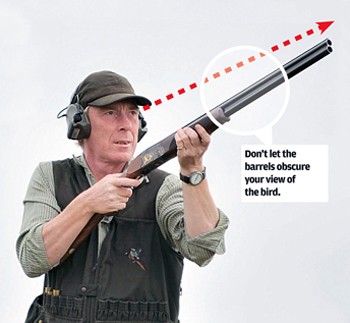How to shoot long range targets and high birds
Clay shooting lessons: How to shoot long range targets and high birds! Mark Russell looks at evaluating long range and…
Win CENS ProFlex DX5 earplugs worth £1,149 – enter here
Many shooters, irrespective of whether they're into clays or game, often struggle to hit high birds

There are many reasons why high birds are missed. It could be:
The most likely reasons for high birds to be missed is because the shooter pulls the trigger when his face is not planted firmly on the stock. He’s either mounted the gun correctly (he should have as he’s had all the time in the world to see the bird coming) but then for some reason lifted his head away from the stock, probably to get a better view of the bird.
Or the shooter has simply thought ‘this appears really slow and easy’ and didn’t give the bird the attention it deserved.
Pulling the trigger before the gun’s mounted correctly – when it’s not pointing where you’re looking – is a recipe for disaster and should be avoided at all costs. The fact you have to tilt your head and neck back further than you would for normal crossing or incoming targets (simply because the angle of the muzzles relative to the ground is greater) is no excuse for shoddy mounting. If you recognise this as a flaw in your technique, practice dry mounting the gun until you can get it right first time, every time.
It’s also important to remember to try and achieve a parallel gun mount, whatever the angle of the muzzles.
Mount the gun correctly when you’re after high birds and you’re half way on the way to increasing your hit rates.
Which bird you’re after, or however the clay is presented what you need to remember is the basic difference between clays and game.
A steady and calculated approach will pay off when you’re shooting high birds. However you can opt for shooting instinctively at a late-seen bird, but wait a while if you want to use this technique as your normal shooting style.
Don’t try to mount the gun too soon because a high bird will usually be in view for a while. If you mount too quickly you’ll probably aim at the bird, rather than in front of it. Your gun will also weigh heavily and you will have arm ache at the end of the day.
You need to be steady to shoot high birds so practise moving the weight from your front to your back foot.
Let’s assume you’re a right-handed shooter (if you’re not it’s the opposite). Your weight distribution needs to be taken from the toe of the left foot (normal for most targets), through a neutral flat-footed stance and then smoothly onto the heel of your right foot.
A gentle rolling action is generally the most effective way to achieve this. The golden rule is to make sure you don’t keep the weight on the front foot and simply bend from the waist. If you do you’ll restrict your swing, probably miss your bird – and ultimately end up with a bad back!
Keep the muzzles up when you see or call for the bird, but not so high that they obscure your view. Don’t mount the gun too early and try to pull away rather than swing through.
Be ready to transfer your weight onto the back foot if necessary.
Clay shooting lessons: How to shoot long range targets and high birds! Mark Russell looks at evaluating long range and…
High driven pheasant shooting lesson: It’s getting to that time of the year when the birds are really beginning to…
A: In more recent years it has become fairly standard practice for over-unders to be multi-choked, thereby opening up a dilemma for many shooters about what…
Get the latest news delivered direct to your door
Discover the ultimate companion for field sports enthusiasts with Shooting Times & Country Magazine, the UK’s leading weekly publication that has been at the forefront of shooting culture since 1882. Subscribers gain access to expert tips, comprehensive gear reviews, seasonal advice and a vibrant community of like-minded shooters.
Save on shop price when you subscribe with weekly issues featuring in-depth articles on gundog training, exclusive member offers and access to the digital back issue library. A Shooting Times & Country subscription is more than a magazine, don’t just read about the countryside; immerse yourself in its most authoritative and engaging publication.

